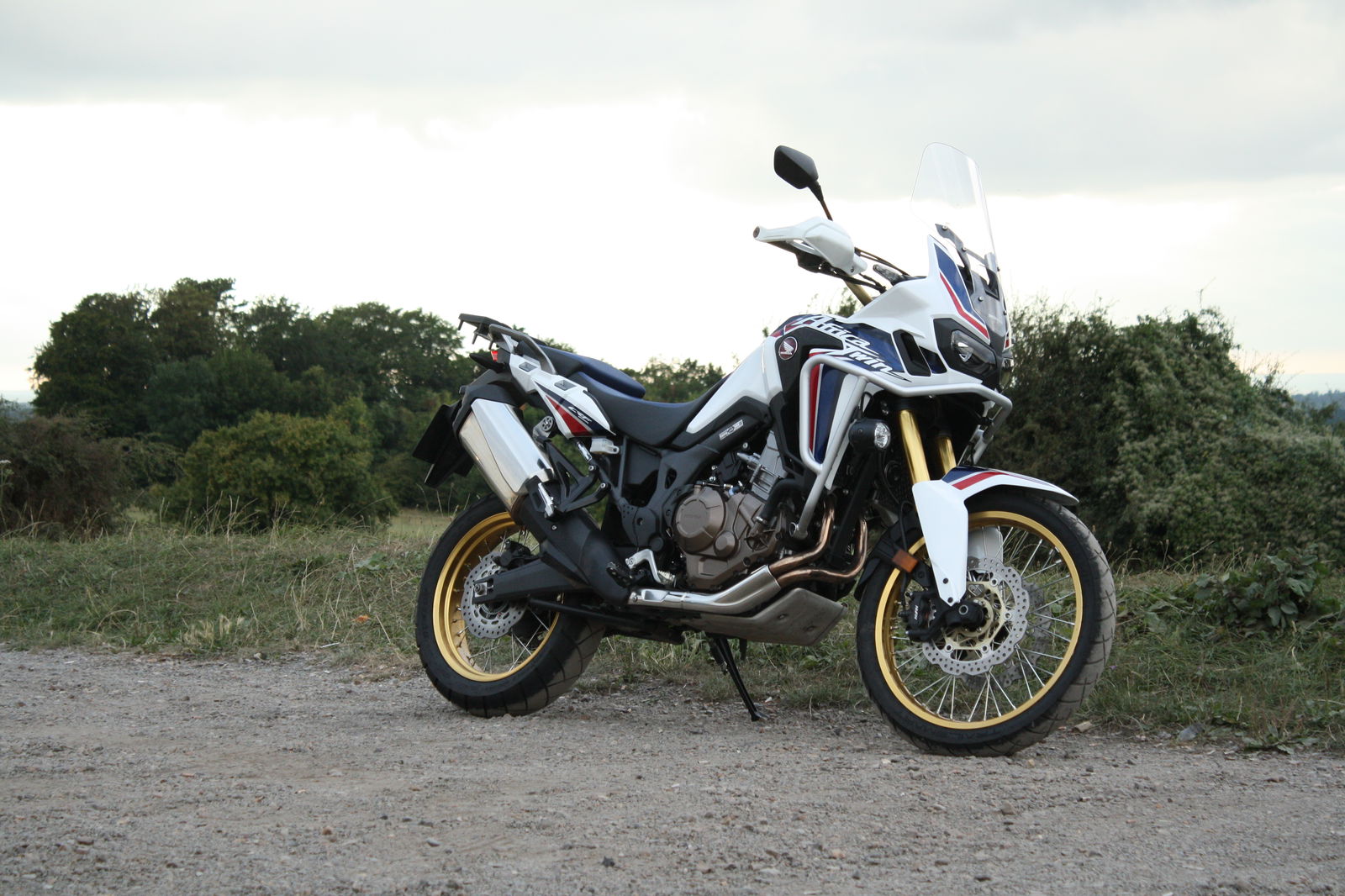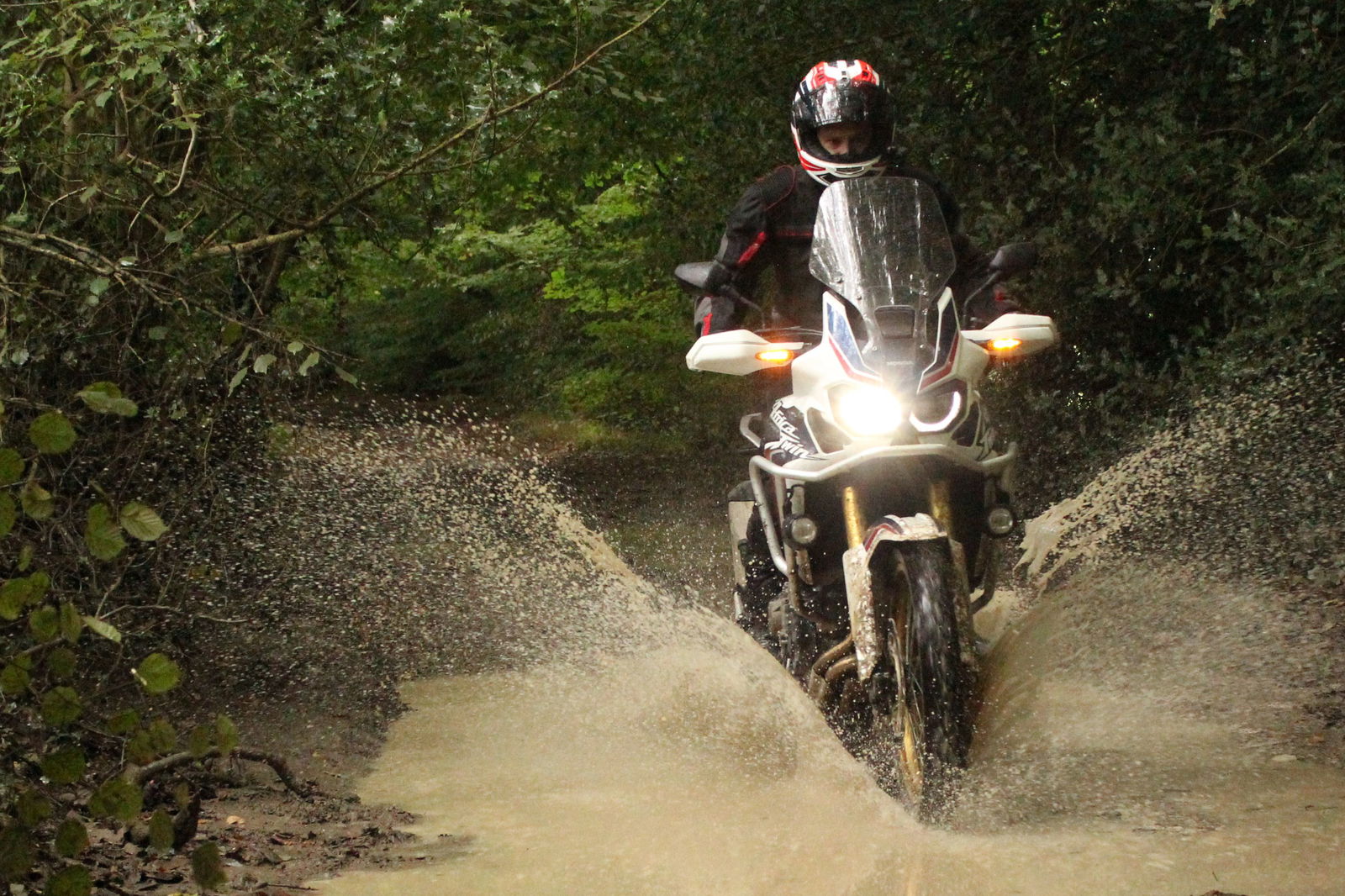Back-to-back test: BMW R1200GS Adventure vs Honda Africa Twin review
The country’s two best-selling big bikes go head-to-head on road and trail

BMW’S R1200GS has long been a colossus of motorcycles sales, dwarfing the numbers achieved by other big bikes and even beating most of the mass-selling small commuters.
It’s arguably the bike that made BMW Motorrad the brand it is today, transforming it from a staid maker of plod bikes to one with the profits to develop class-changing machines like the S1000RR.
With a little help from Ewan McGregor and his babbling friend Charley, of course.
It’s also the reason the big adventure bike class is now so populated, with every manufacturer desperate to get in on the Ewan and Thingy phenomenon but none able to… until now.
This year saw the launch of the new Honda Africa Twin, and it hasn’t been hanging around in showrooms for long.
By the end of March, Honda had sold 603 Honda Africa Twins compared to 662 GSs – the closest any big bike has come to matching the BMW in ages.
Time to dust off the adventure twat suit, then, and pit these two bikes against each other in an on-and-off-road dust-up.
I’d ridden the R1200GS before, at the launch a couple of years ago, but there’s one way in which it always manages to surprise, even though I already know it’s true. It’s not only a colossus of motorcycle sales. It’s also just a colossus.
I mean this thing is huge; a preposterous vehicle to consider taking off road. Naturally we went for the GS Adventure model, bigger still than the base one, with a 30-litre tank instead of 20, and widened even more by crash bars to protect the engine. At least they are supposed to protect the engine. But we’ll come to that.
“Is that the world’s biggest motorcycle?” asked my eight-year-old son when he saw it in the garage.
“Yes,” I told him.
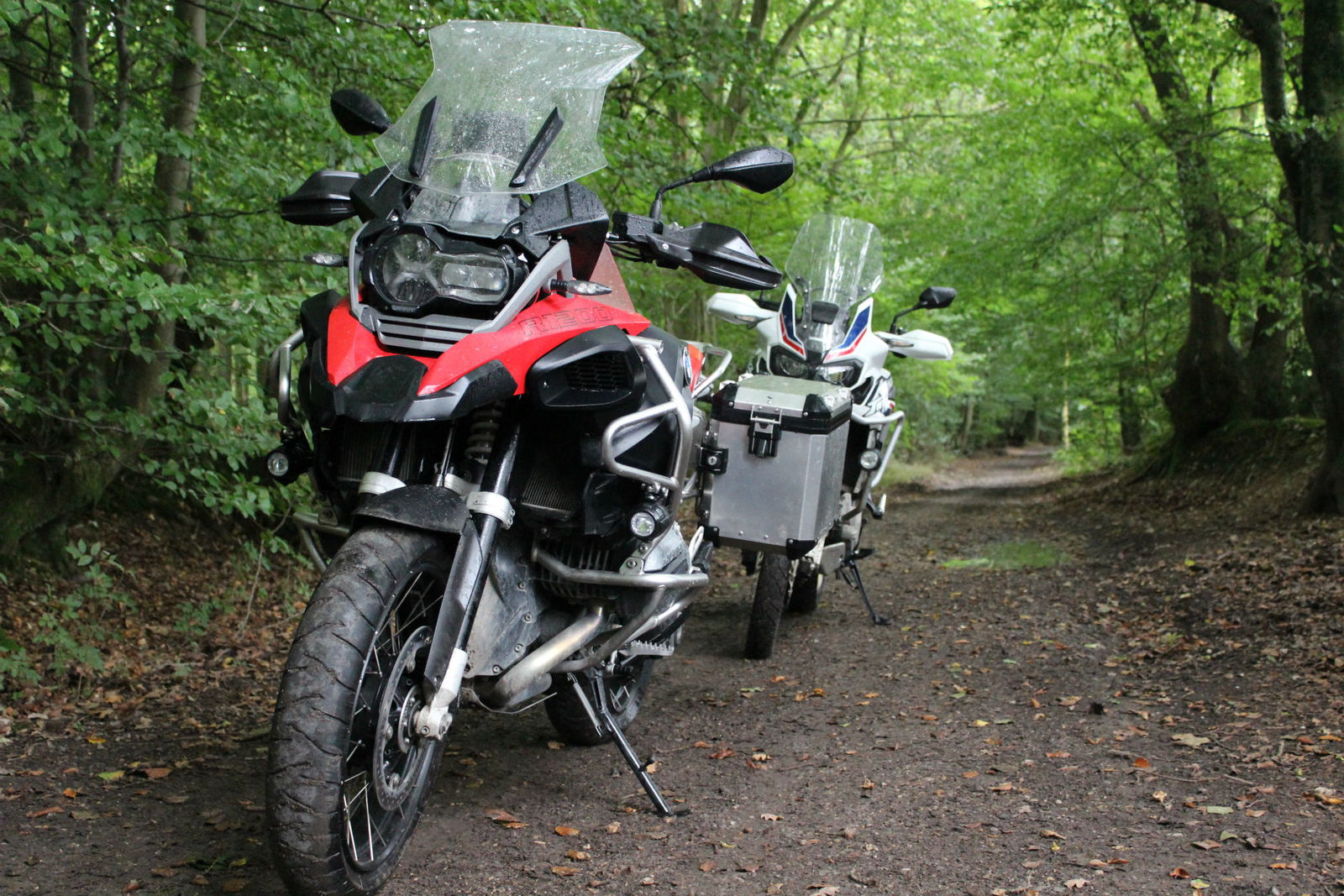
There's an Africa Twin hidden somewhere behind the humongous GS Adventure.
It’s not hard to see why people love the GS. It’s a fantastic road bike: extremely comfortable with a strong, engaging engine, excellent handling and suspension, very powerful Brembo monobloc brakes and a sophisticated electronics package.
It’s got BMW’s traction control system, called Automatic Stability Control. There are two riding modes as standard, Road and Rain, plus a further three optional ones: Dynamic, Enduro and Enduro Pro. Enduro Pro turns ABS off at the back wheel.
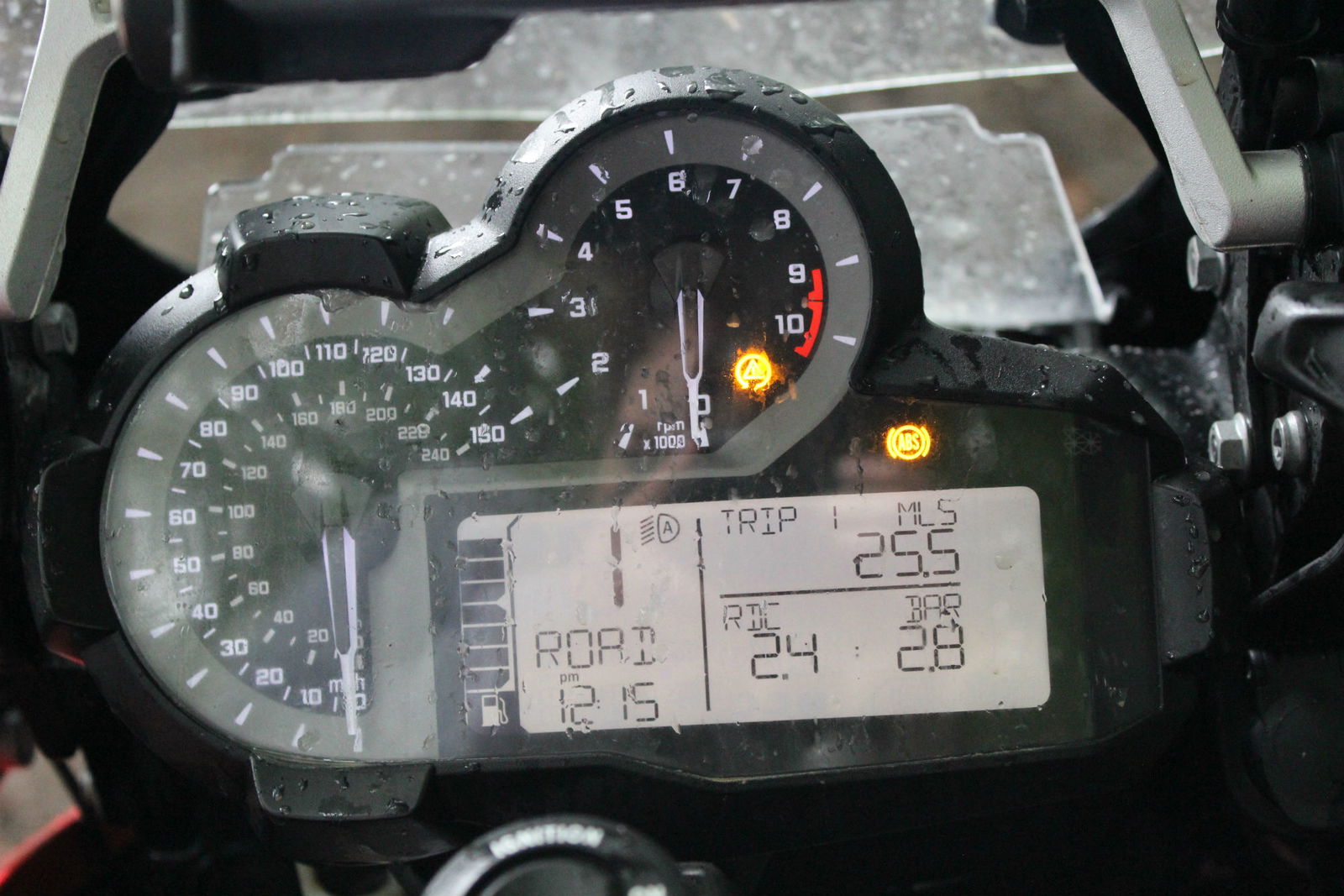
The test bike supplied featured semi active suspension, an option costing £755, with Hard, Soft and Normal settings which you select by pushing a button.
It’s got so may options you need a twirly dial on the left-hand handlebar and six months to work it out.
Other accessories fitted to the test bike included heated grips (£240) and a keyless ignition (£250).
There’s also an optional quick-shifter, called Gear Shift Assist Pro (£375) and cruise control (£395).
And that’s barely half the list of options. This bike comes with a lot of stuff if you’ve got the money.
On my 60-mile ride home from work, I couldn’t think of a machine I’d rather be on. Sitting upright, with the screen at its highest setting (just below eye-level), on a big seat, with the suspension set to Soft (it’s comfy in any mode), the GS seems as capable of eating motorway as probably any bike you could buy.
The 125hp, 1170cc liquid-cooled boxer-twin isn’t breaking sweat and the screen quietens the wind. The screen’s easily adjusted by twirling a knob with one had to wind it up or down. There’s a kind of whooshing noise from about 40mph which I thought might be caused by air rushing through a gap at the bottom of the screen. It’s slightly annoying but a lot quieter that unfettered windblast in the face.
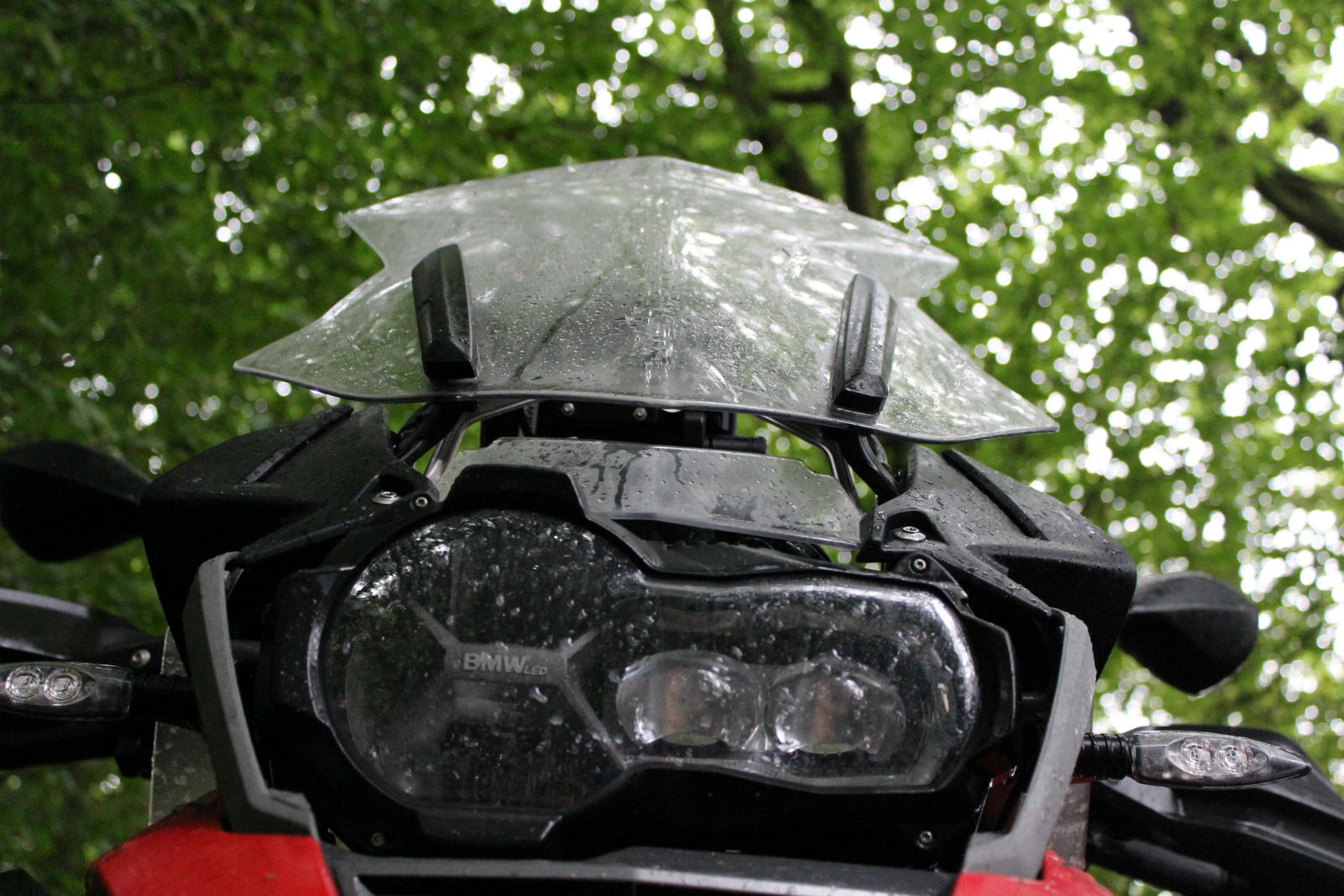
Something makes a whooshing sound at over 40mph, possibly the wind going through that gap.
The next day, on an hour-long ride to our chosen off-road location, the GS showed it was just at home on twisty tarmac.
It handles superbly for a 263kg machine, changing direction with the ease and precision of something lighter, and the boxer engine is well up to quickly firing that bulk down the straights, with a broad enough spread of torque to not have to worry much about what gear you’re in.
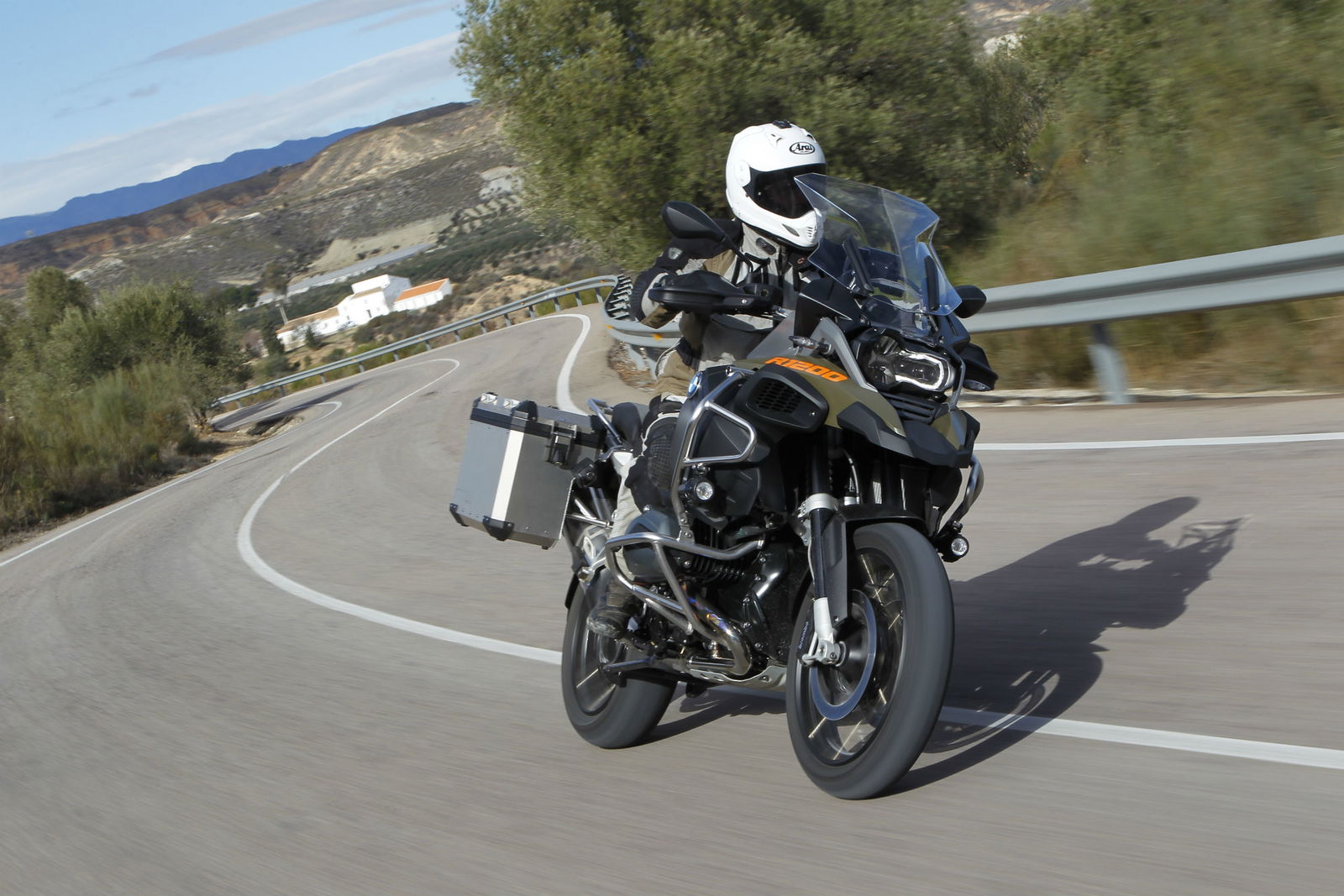
Tackling twisties on the GS at the launch in Spain.
Compare all that long-distance and back-road prowess to that of the Africa Twin. The Honda’s competent in all respects – but I don’t think it’s quite the accomplished road bike the BMW is.
It’s comfortable but not to the same degree. It’s perfectly happy at motorway touring speeds but a little more vibey – compared to the GS it feels like it needs another gear. The screen is tall (about chin-height for this 5’9” rider) but non-adjustable. The level of wind protection is good though.
On bendy roads the 21-inch front wheel feels slightly less willing to change direction than the BMW’s 19-inch one. You’re certainly aware of the bigger circumference, anyway, and it doesn’t feel as good on the road.
The front brake – the same Nissin four-pot set-up as found on the CRF450 Rally - are good but not up there with the BMW’s.
The Africa Twin makes 94hp. Not amazing for a 998cc parallel-twin but not a washout either. Importantly, peak torque is a relatively high figure, at 72lbft.
The Africa Twin will go fast. That torque lets you overtake rapidly without changing down and when you hold on to a gear it charges on with pleasing anger.
We borrowed the automatic version, with Honda’s Dual Clutch Transmission. That means that if you just whack the throttle open, it holds onto the gear for you until near the red line.
There’s a ‘D’ mode and an ‘S’ mode, for Drive and Sport, the former making gear choices for more economy and the latter for more, well, sport. Actually there are three S modes, offering progressively more performance-focused gear choices.
You can also override its automatic choices with two button shifters on the left handlebar.
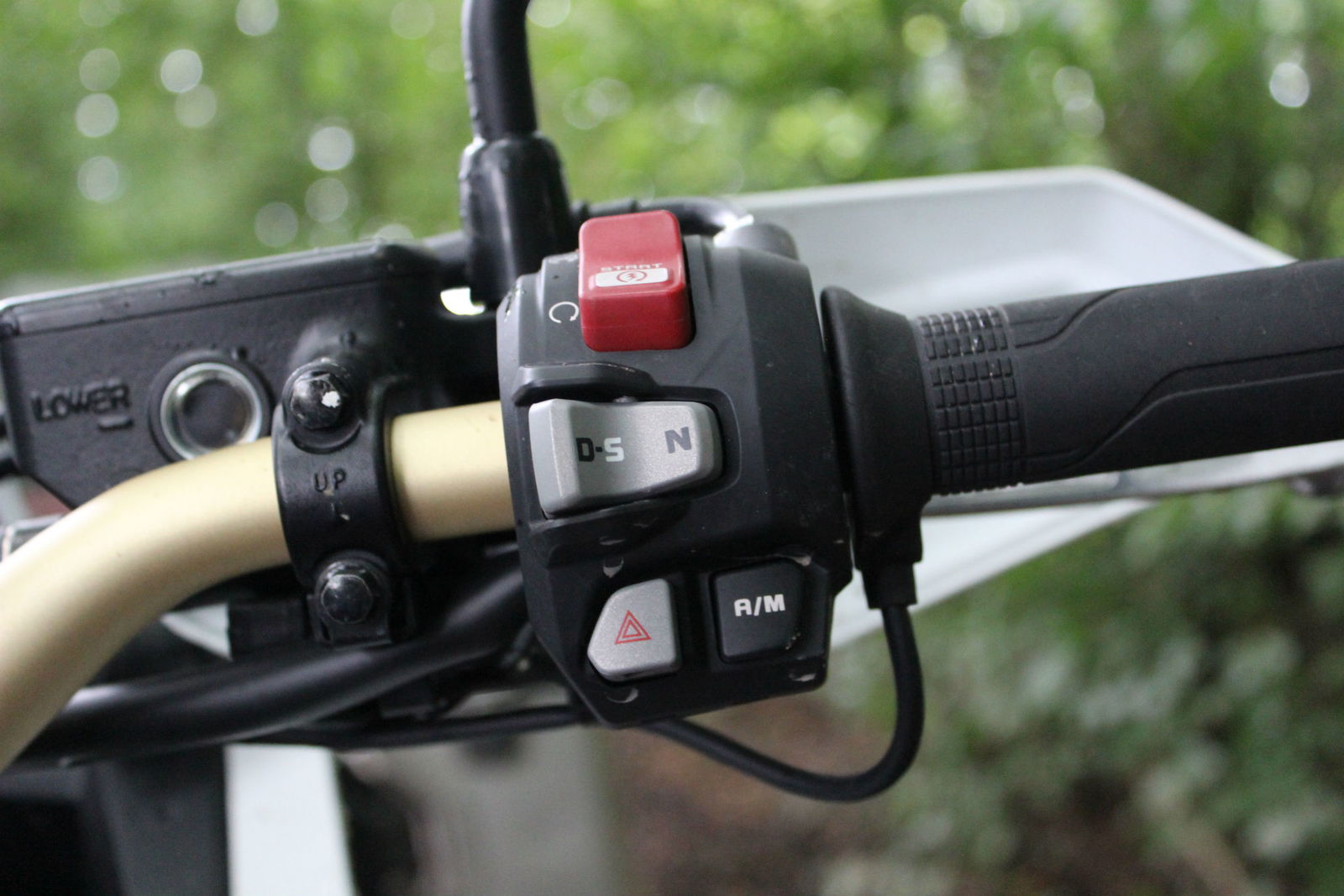
I like the Africa Twin’s engine but only an imbecile would claim it has the character of the BMW’s when ridden in anger of the road.
The boxer is a piece of Bavarian art. The Honda parallel-twin is a Honda parallel-twin. On the launch in December, I wrote that it was like a bigger and more powerful NC750 engine. With the Africa Twin’s high torque and low red line, at just under 8,000rpm, I still think that’s a fair observation, although it didn’t please everyone.
It’s not even a criticism. The engine does exactly what it’s supposed to, like all Hondas, and sounds quite good too. It just doesn’t quite do it with the meaty, rumbling flair of the boxer. Or the power of course.
Another point I made on the launch, which I also stick to, is that the DCT doesn’t quite come together on the road. Whatever the mode, it makes choices you don’t want, changing up too early or hanging on to a gear when you’ve stopped accelerating. Sometimes you override it and it changes back and you think ‘Who’s in charge?’
The challenge for DCT is that, if it’s going to make gear choices for you, it has to get them consistently right. If you have to correct it, you might as well do it all yourself. That’s what I always end up thinking, anyway: ‘Just move out of the way and let me do it, then. Go home.’
In fairness to it, you can do this if you want, by choosing a manual mode, and making all the gear choices yourself.
The electronics also include three-level traction control, which can be switched off, and ABS, which can be switched off at the back wheel. Selecting the settings you want is a simple and intuitive process using the buttons on either bar.
What can be said of the Africa Twin on the road is that it’s a much more manageable prospect than the GS at low speed. Need to paddle it backwards? Not a problem. Now try that on the Beemer. You’ll do it, but unless you’re quite tall you’ll be straining for purchase with your toes.
Even with DCT, the Africa Twin is 21kg lighter than the GS Adventure, and feels it. Without DCT it’s another 10kg lighter still.
The seat height can be adjusted from 850mm to 870mm, while the GS is either 890 or 910. The Africa Twin’s seat is also narrow. As a result, it’s much easier to get more foot on the ground.
The Africa Twin’s smaller dimensions and lighter weight also make it a less intimidating prospect in low-speed manoeuvres, like U-turns.
But of course this is all only half the story. These are adventure bikes, right? So let’s get them off road.
We chose a one-mile stretch of muddy, stony byway in Hampshire, with a few deepish puddles. Something that would be no sweat on a lightweight trail bike, like KTM’s Freeride 350, but which you’d never tackle on a bike without some off-road capability. Just the right level of difficulty, we thought, for these bikes and our level of off-road ability, which is pretty average (in common with many big adventure bike owners, I suspect).
I don’t mind admitting I was nervous as I arrived at the trail on the GS. My biggest concern was probably the Michelin Anakee III dual-sport tyres, which looked basically like road rubber with slightly deeper tread in the middle.
The Africa Twin was on dual-sport tyres too – Dunlop Trailmax – but they at least looked more the part, with deeper and wider tread.
The GS Adventure can be supplied with off-road rubber at no extra charge, but that wouldn’t be as good on the road. And the Michelin Anakees are dual-sport, aren’t they? They’re not pure road rubber. They’re a compromise, supposedly offering some level of competence in either setting, letting you have fun on the road and tackle a gentle trail. That’s the whole point, of them and the bike – to go anywhere. That’s the proposition we were here to test – but I’d have been happier without the light rain, slowly making the trail all slimy.

Having said that, the only apparent compromise to ‘dual-sport’ made by these tyres is slightly deeper tread in the middle. Otherwise they look like road tyres. And it had been raining lightly than morning, making everything nice and slimey. So I was nervous.
Not for long though. An initial slightly ginger run established this bike and these tyres of course could tackle this not-too-challenging trail, even in the hands of an average rider like me. The tyres didn’t slip about as much as I had feared they would. The puddles, probably calf deep in places, took a little faith (what’s under that water?). But with a bit of momentum, and my eyes focused optimistically on the other side, the bike went straight through with not a moment of doubt.
After a few runs up and down, confidence and speed building, I really started to enjoy myself. And It became clear that, yes, these bikes really can do it. Some riders like to scoff at the notion of them having off-road ability, saying they’re too big and heavy - but you really can ride one to a green lane and keep going. You’re not going to try a vertical hill-climb, unless you’re a Dakar veteran, but they do exactly what they’re supposed. You can keep going when the road ends.
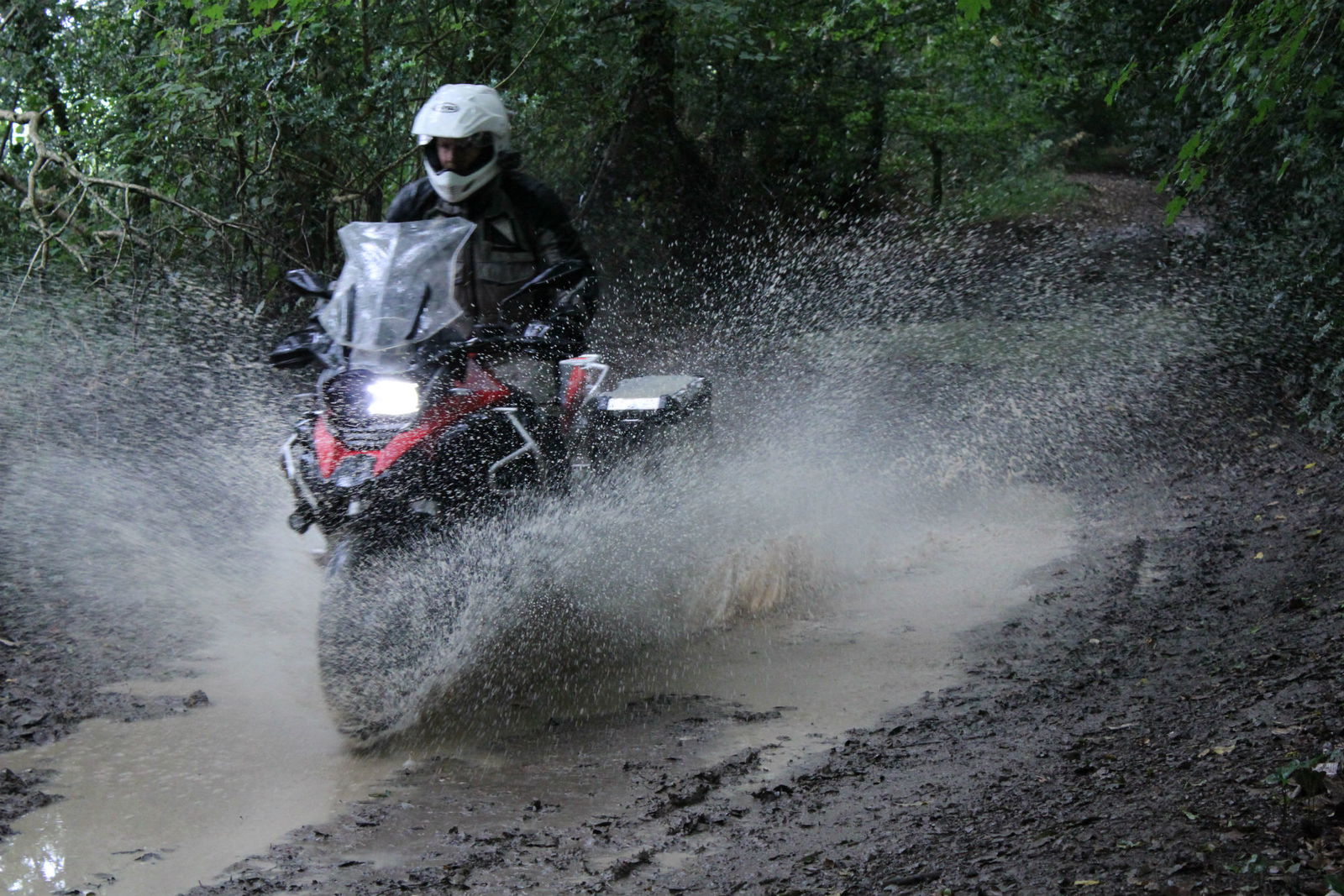
We were having fun.
Or I was. I’m sure Visordown reporter Simon Greenacre was too, until he parked the Africa Twin in the bushy lower branches of a tree, upright, with its wheels on the ground.
Luckily it wasn’t the GS, and we plucked it out without much difficulty. If there was a scratch on it, we couldn’t see it.
I took the opportunity to switch bikes and try the Africa Twin off road for the first time, and what a difference. It’s so much smaller and lighter, and narrower between your knees when you stand up, so it feels more like a bike that’s supposed to be off road.
It’s not so much a matter of faith on the Honda. The lighter weight makes you feel more in touch with the tyres, giving you the confidence to push them more. Gas it and the traction control lets the rear step out, and it’s fun, not terrifying.
As capable as the GS had seemed, the Africa Twin immediately endowed me with the confidence to go faster.
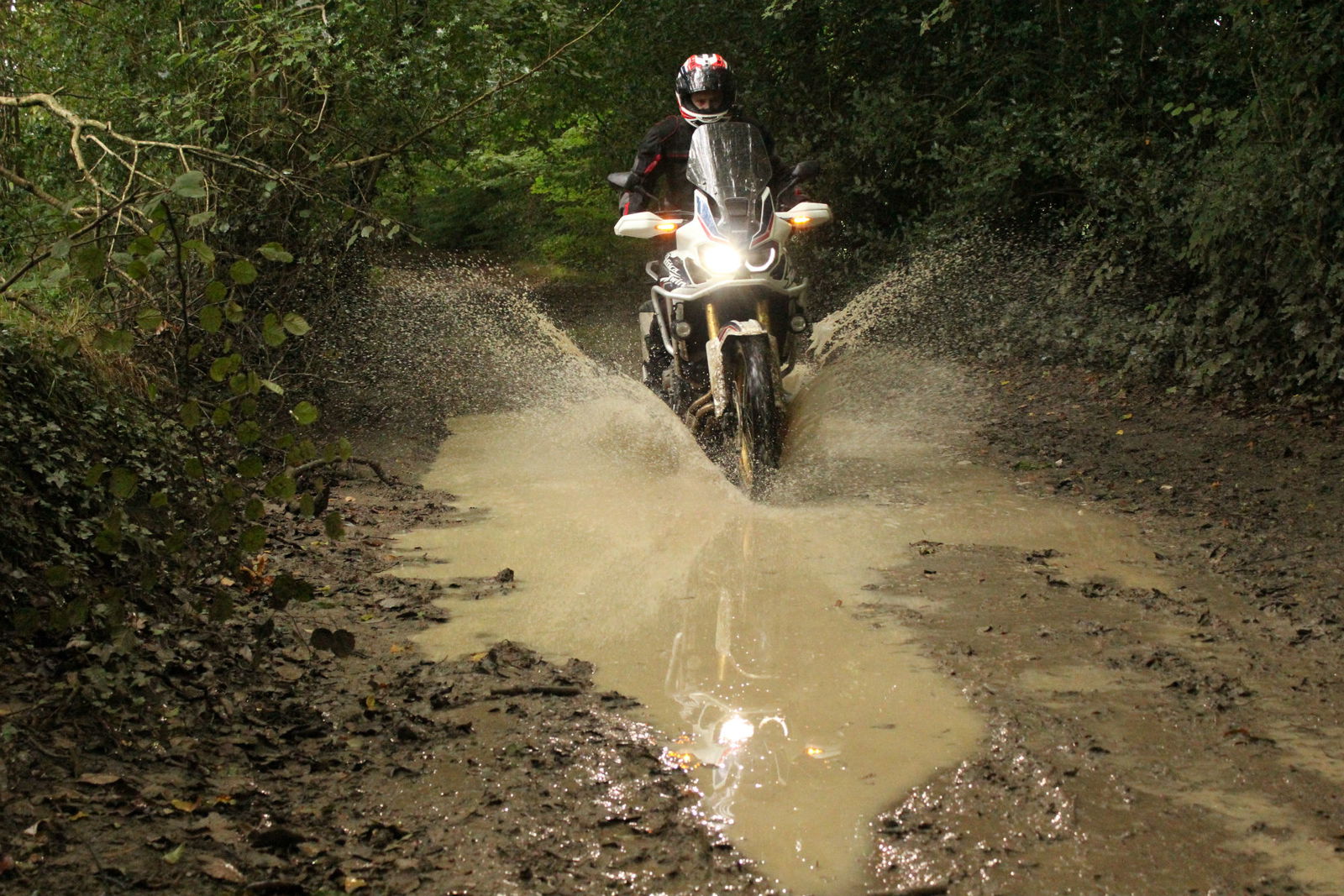
In the dirt, the DCT becomes a big advantage for the inexpert off-road rider. From a host of unfamiliar challenges, one is removed: gear selection while standing up.
The part of your brain that thinks about whether you’re in the right gear while riding the GS is freed to think about other things, like where to point the bike.
In S mode, the DCT does make good gear choices. If you need to change (and I didn’t, really), the button shifters are perfectly positioned to reach with your thumb and forefinger while standing up, one on either side of the bar. It’s much easier than changing gear the normal way with your foot, something I often still find myself sitting down to do, especially on a big bike like the GS.
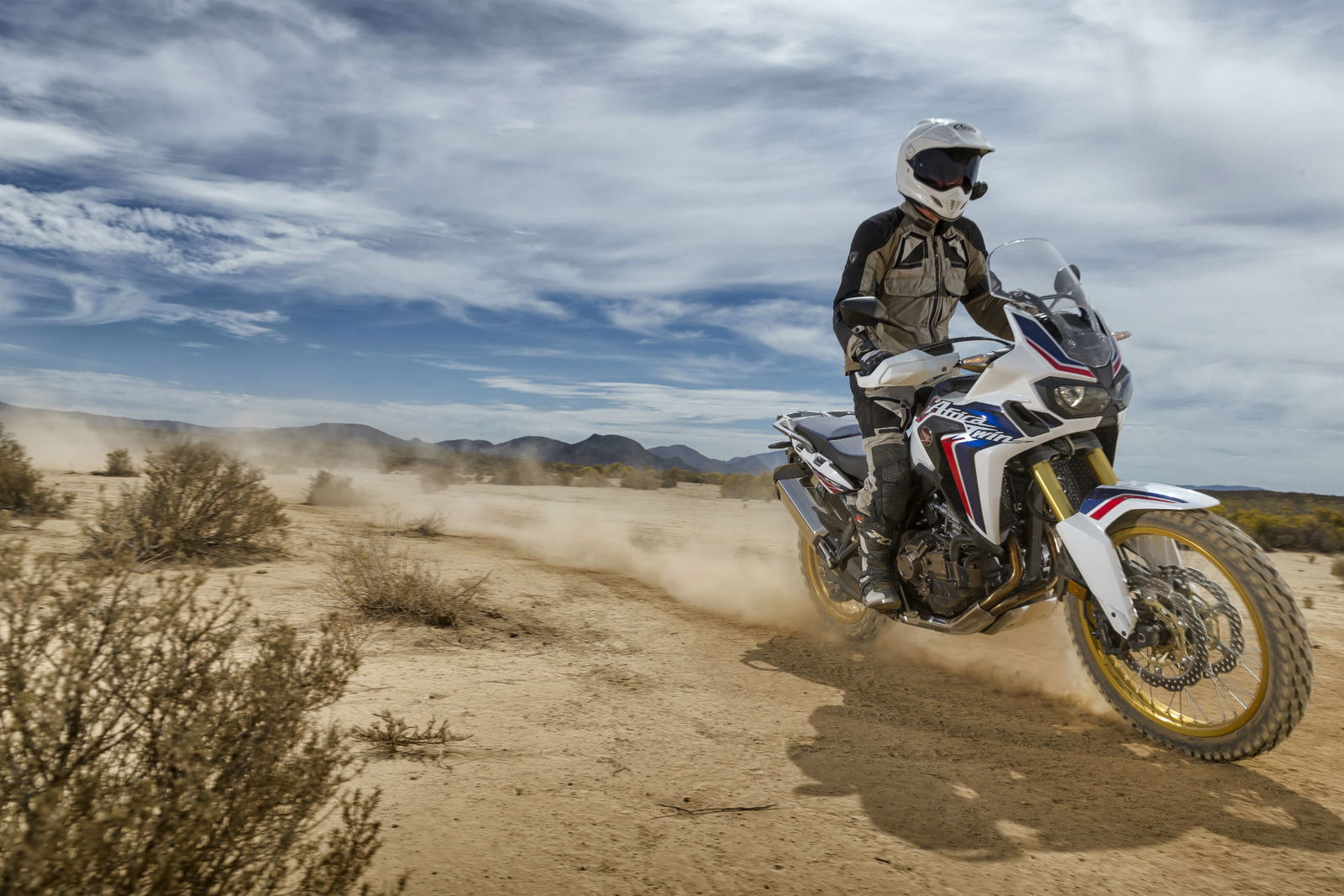
Riding the Africa Twin at the launch in South Africa (not on a muddy trail in Hampshire).
I got to the end of the trail and looked back to see how far ahead I was of Simon on the GS. I waited. And waited. And then I went back.
“I don’t know what happened?” he said.
The front had lost traction and gone sideways, in a straight line, at perhaps 15mph. Maybe we had expected too much of those tyres after all.
More illuminating than the crash itself was the damage it caused: a holed left-hand valve cover and a puddle of oil on the trail, signalling the end of the test.
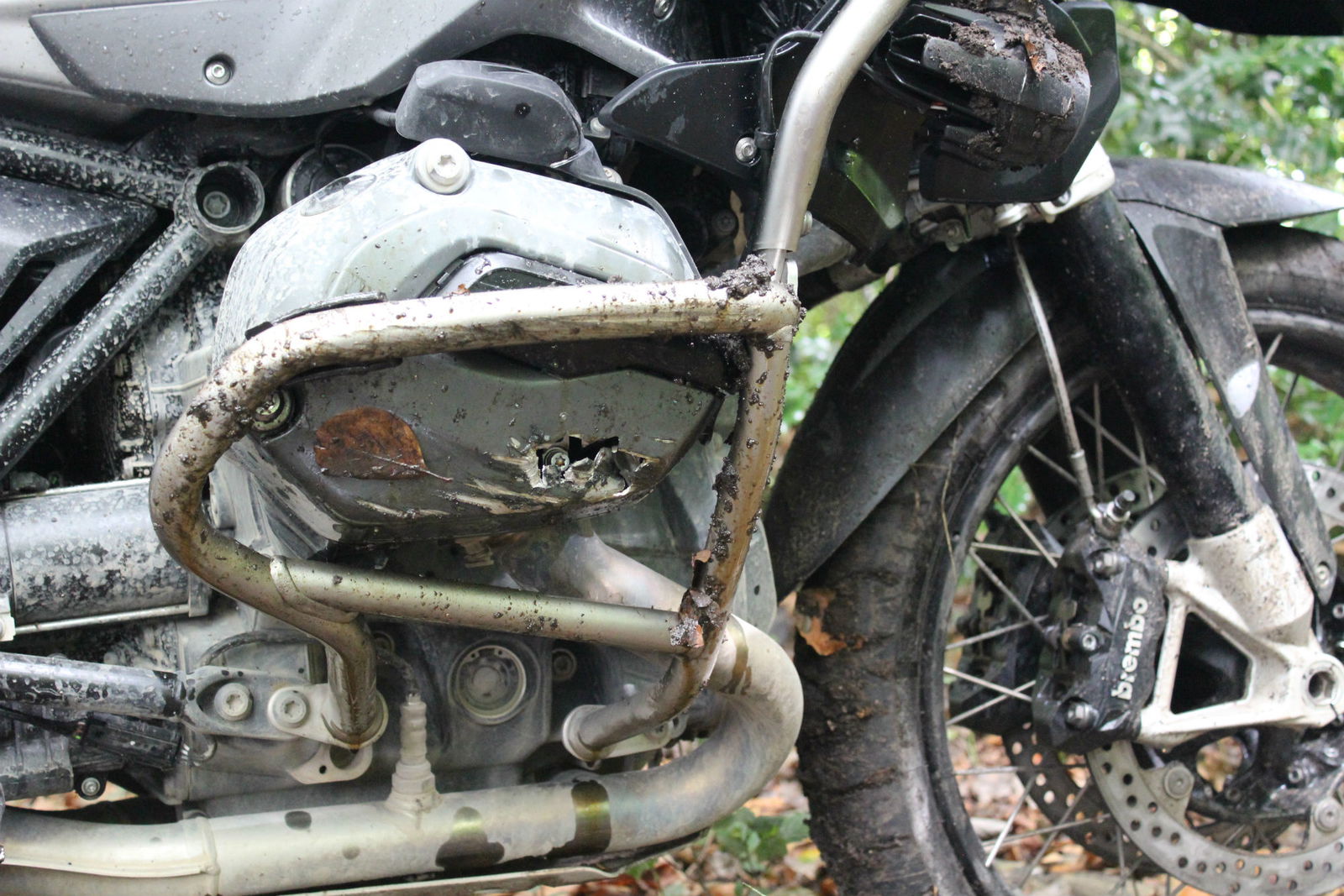
In an expensive way, it highlighted a real limitation of the GS as an off-road machine. Spills do happen off road. A bike which bleeds to death the moment one does, leaving you stranded and in need of a recovery truck, cannot be described as the ideal tool for the job.
And what are those crash bars for, for all the good they did?
The answer is, like the rest of the GS, they are 60% for looking the part. The bike’s hugeness, it’s weight, the awkwardness of moving it about (something we found out all about as we pushed it back to road) is all part of the appeal. It’s a bike that says ‘Experts only’. That’s why it’s so popular, not because of its off-road ability, although it does have some.
And it’s where the Africa Twin is so different. They’re both excellent motorcycles. Which is best for you will depend on your expectation of what an adventure bike should be.
If you think it should be a brilliant long-distance road bike, capable of tackling some dirt too, it will be the GS. If you think it should be a bike you might actually be able to ride to remote corner of the world on (without a film crew and support track), over mud, rock, sand, and tarmac if really necessary, then it’s the Africa Twin.
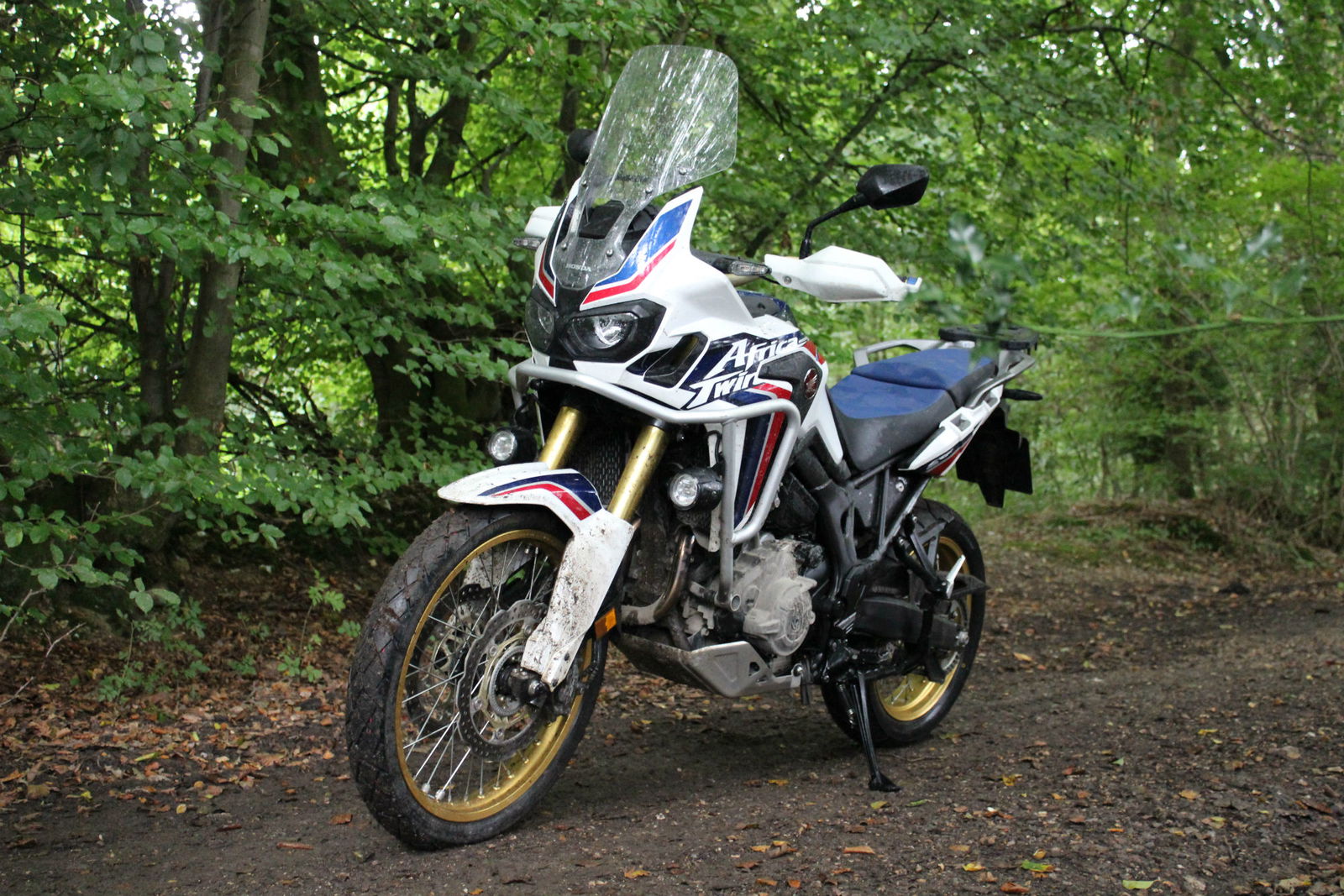
Model tested: Honda CRF1000L Africa Twin
Price: £10,499 (£11,299 with DCT)
Engine: 998cc liquid-cooled parallel-twin
Power: 94hp @ 7,500rpm
Torque: 72lbft @ 6,000rpm
Kerb weight: 232kg (non-DCT model)
Frame: Steel semi-double cradle
Suspension: 45mm fully adjustable USD fork with 230mm of travel. Fully adjustable shock with 220mm of travel
Brakes: Front 310mm wave floating discs, two-piece radial-mounted four-piston calipers. Rear 256mm wave disc.
Wheels: Wire-spoked 21" x 2.15" front and 18" x 4" rear
Tyres: Dunlop Trailmax 90/90-21 front and 15/70-18 rear, tubed
Seat height: 870mm (low position 850mm)
Fuel capacity: 18.8 litres
Claimed fuel economy: 61.2mpg (61.5mpg for DCT model in Drive mode)
Colours: black, silver, 'Victory Red' or 'Tricolour'
Availability: now
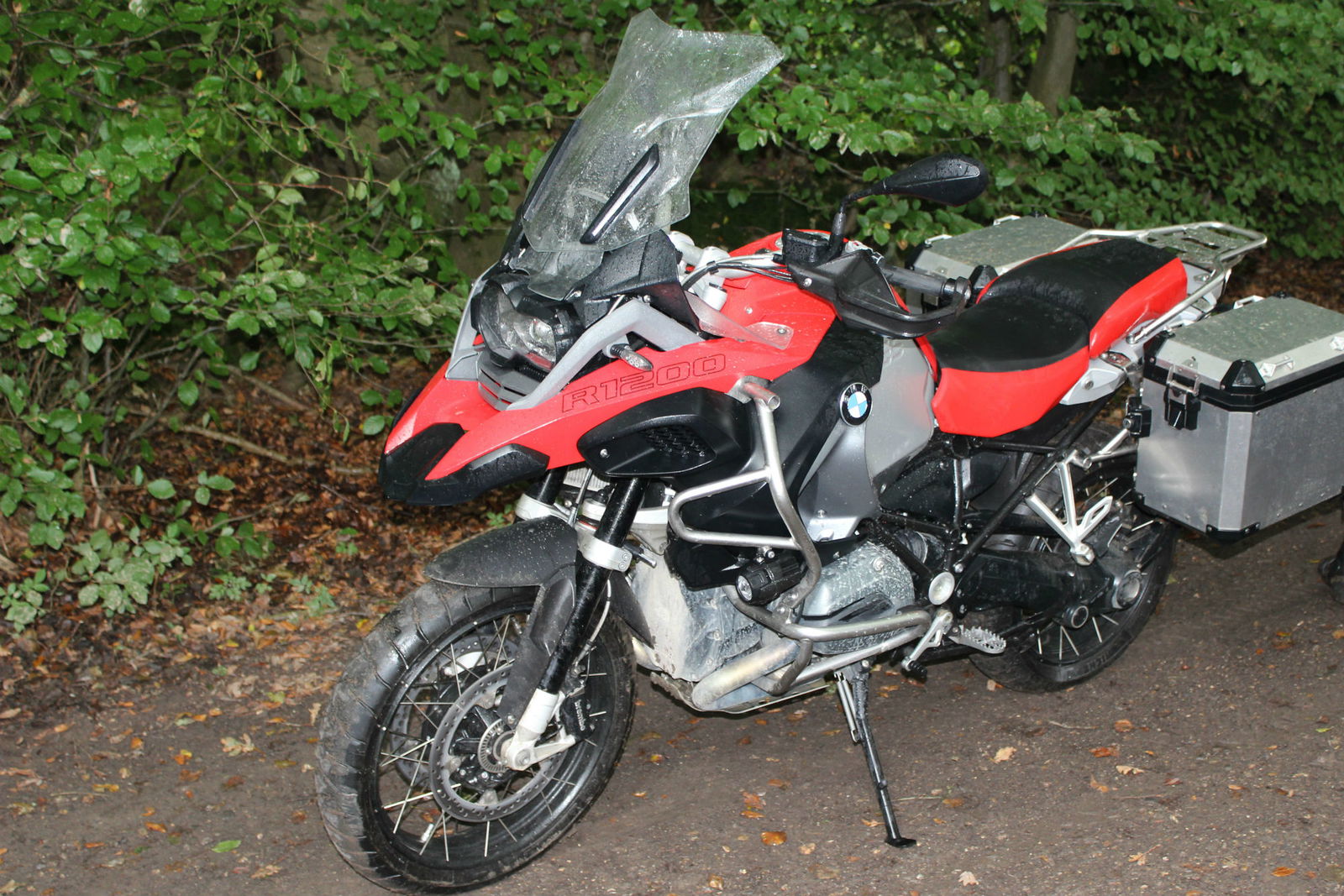
Model tested: BMW R1200GS Adventure
Price: From £13,050
Engine: 1170cc liquid-cooled boxer-twin
Power: 125hp @ 7,750rpm
Torque: 92lbft @ 6,500rpm
Kerb weight: 363kg
Frame: Two-section steel frame, front and bolted-on rear frame, load-bearing engine
Suspension: Telelever 37mm front fork. Rear shock adjustable for preload and rebound damping.
Brakes: Twin 305mm front discs with four-piston radial Brembo brake calipers. Single 276mm rear disc.
Wheels: Wire-spoked 19" x 3" front and 17" x 4.5" rear
Tyres: Michelin Anakee III 120/70-19 front and 170/60-17 rear
Seat height: 890/910mm
Fuel capacity: 30 litres
Colours: ‘Racing red matt’, ‘Light White’
Availability: now
